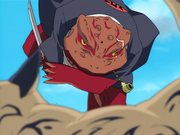No edit summary |
LeafShinobi (talk | contribs) mNo edit summary Tag: sourceedit |
||
| (39 intermediate revisions by 24 users not shown) | |||
| Line 1: | Line 1: | ||
| + | {{Infobox/Jutsu |
||
| − | *'''Name:''' {{translation|Toad Sword Beheading||Gamadosuzan}} ''English'' "Toad Blade Cut" |
||
| + | |ref=<ref>Second Databook, page 206</ref> |
||
| − | *'''Type:''' A-rank, Offensive, Mid to long range (5+m) |
||
| − | + | |image=Gamabunta gara.png |
|
| + | |kanji=蝦蟇ドス斬 |
||
| + | |unnamed jutsu=No |
||
| + | |romaji=Gamadosuzan |
||
| + | |literal english=Toad Sword Beheading |
||
| + | |english tv=Toad Blade Cut |
||
| ⚫ | |||
| + | |jutsu class type=Offensive |
||
| + | |jutsu range=Mid, Long |
||
| + | |users=Gamabunta, Gamakichi, Gama~game |
||
| + | |debut manga=135 |
||
| + | |debut anime=78 |
||
| + | |debut shippuden=No |
||
| + | |game debut=Naruto: Ultimate Ninja |
||
| + | |jutsu media=Anime, Manga, Game |
||
| + | }} |
||
| + | A technique which only [[toad]]s can use, by employing its characteristic bodily features. Its strong hips and legs give birth to an uncommonly precise leap, with which it slices at its target. Since the interval is covered in the blink of an eye, the opponent can't even try to escape. Gamabunta uses this together with his huge dosu ([[Wikipedia:Aizukotetsu-kai|Yakuza sword]]).<ref>Chapter 135, pages 3-4</ref> |
||
| + | == Trivia == |
||
| − | This jutsu involves Gamabunta using his huge dosu (Yakuza sword) to attack his opponent. |
||
| + | * In ''[[Naruto Shippūden: Ultimate Ninja Storm 4]]'', Gamakichi was shown to be capable of further increasing the strength and effectiveness of this technique by applying [[chakra flow]]. |
||
| + | == References == |
||
| − | [[Category:Jutsu]] |
||
| + | <references/> |
||
| ⚫ | |||
Revision as of 19:06, 13 April 2015
A technique which only toads can use, by employing its characteristic bodily features. Its strong hips and legs give birth to an uncommonly precise leap, with which it slices at its target. Since the interval is covered in the blink of an eye, the opponent can't even try to escape. Gamabunta uses this together with his huge dosu (Yakuza sword).[2]
Trivia
- In Naruto Shippūden: Ultimate Ninja Storm 4, Gamakichi was shown to be capable of further increasing the strength and effectiveness of this technique by applying chakra flow.

